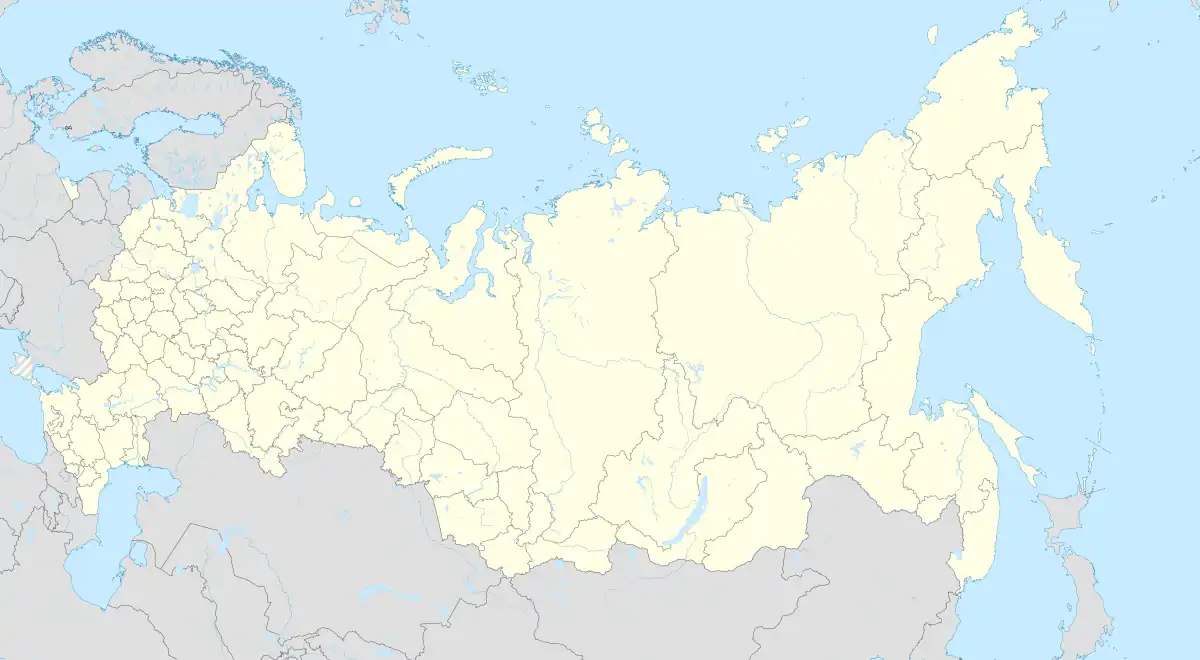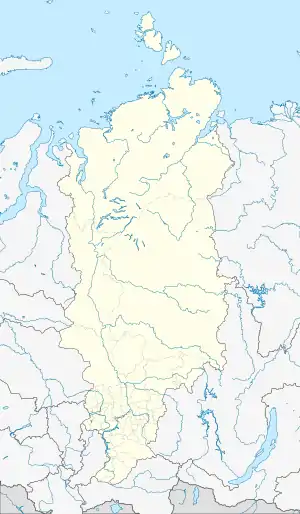Igarka
Игарка | |
|---|---|
.jpg.webp) Igaraka from the Yenesei River | |
 Flag  Coat of arms | |
Location of Igarka | |
 Igarka Location of Igarka  Igarka Igarka (Krasnoyarsk Krai) | |
| Coordinates: 67°28′N 86°35′E / 67.467°N 86.583°E | |
| Country | Russia |
| Federal subject | Krasnoyarsk Krai[1] |
| Administrative district | Turukhansky District[1] |
| District town | Igarka[1] |
| Founded | 1929 |
| Town status since | 1931 |
| Elevation | 20 m (70 ft) |
| Population | |
| • Total | 6,183 |
| • Capital of | District town of Igarka[1] |
| • Municipal district | Turukhansky Municipal District[3] |
| • Urban settlement | Igarka Urban Settlement[3] |
| • Capital of | Igarka Urban Settlement[3] |
| Time zone | UTC+7 (MSK+4 |
| Postal code(s)[5] | 663200 |
| OKTMO ID | 04654117001 |
| Website | igarkacity |
Igarka (Russian: Ига́рка) is a town in Turukhansky District of Krasnoyarsk Krai, Russia, located 163 kilometers (101 mi) north of the Arctic Circle. Igarka is a monotown established around a sawmill which processed timber logged in the basin of the Yenisei River for export. Up to 1956, it was largely inhabited by deportees and political prisoners.[6] Since the dissolution of the Soviet Union in 1991, the town's population has rapidly declined – it decreased from 18,820 (1989 Census)[7] to 4,417 (2019).[6]
History
Igarka was founded in 1929 as a sawmill and a timber-exporting port by the Chief Directorate of the Northern Sea Route.[8] Timber was logged in the basin of the Yenisei River, floated to Igarka where it was processed, and then exported to various distribution centers. The town grew rapidly as deportees during the dekulakization campaigns were sent to the town. Igarka was granted city status in 1931.[8] The town's construction was directed by Boris Lavrov who envisioned Igarka as an ideal Soviet Arctic city. In 1939, the town reached its peak population of 23,648. Further development was suspended due to World War II, but resumed in the late 1940s when Igarka was envisioned as a naval port.[8]
From 1949 to 1953, the Salekhard–Igarka Railway project made an unsuccessful attempt to connect Igarka to the Russian railway network at Salekhard, claiming the lives of thousands of Gulag prisoners.[9] During the deportations of 1948–1951, thousands of civilians were deported to Igarka from the newly occupied territories of the Soviet Union. Some 6,000 to 10,000 Lithuanians were deported during the Operation Spring in May 1948 alone.[6] About 1,000–3,000 of them died from the cold and poor conditions in the first year.[6]
After the death of Stalin in 1953, the Salekhard–Igarka Railway project was abandoned and many deportees were allowed to return home.[8] However, the town recovered and by 1965 it was the second largest lumber-exporting port in the Soviet Union. During this era, the town saw construction of typical concrete housing blocks. After the dissolution of the Soviet Union in 1991, the sawmill was not viable in the new free-market environment due to the high costs associated with the harsh climate conditions and long distances to the buyers. The sawmill closed in 2000 leading to the rapid decline in the town's population.[8] Increasing mean annual air temperatures led to permafrost thaw which destabilized and structurally impaired many buildings in the town. To reduce maintenance and utility costs of such buildings, the town demolished and controlled burned the historic district of mainly wooden houses in the mid-2000s. The residents were relocated to the newer apartment blocks.[8]
Geography
Climate
Igarka has a subarctic climate (Köppen climate classification: Dfc)
| Climate data for Igarka, 1991–2020 normals, extremes 1929–present | |||||||||||||
|---|---|---|---|---|---|---|---|---|---|---|---|---|---|
| Month | Jan | Feb | Mar | Apr | May | Jun | Jul | Aug | Sep | Oct | Nov | Dec | Year |
| Record high °C (°F) | 1.2 (34.2) |
0.7 (33.3) |
7.2 (45.0) |
13.3 (55.9) |
27.8 (82.0) |
33.6 (92.5) |
34.0 (93.2) |
31.3 (88.3) |
24.8 (76.6) |
14.6 (58.3) |
3.1 (37.6) |
1.0 (33.8) |
34.0 (93.2) |
| Mean daily maximum °C (°F) | −23.2 (−9.8) |
−20.1 (−4.2) |
−10.4 (13.3) |
−2.7 (27.1) |
4.2 (39.6) |
16.5 (61.7) |
21.2 (70.2) |
17.1 (62.8) |
9.1 (48.4) |
−2.6 (27.3) |
−16.1 (3.0) |
−21.0 (−5.8) |
−2.3 (27.8) |
| Daily mean °C (°F) | −27.2 (−17.0) |
−24.7 (−12.5) |
−16.4 (2.5) |
−9.0 (15.8) |
−0.6 (30.9) |
10.9 (51.6) |
15.6 (60.1) |
12.3 (54.1) |
5.3 (41.5) |
−5.7 (21.7) |
−20.1 (−4.2) |
−24.9 (−12.8) |
−7.0 (19.3) |
| Mean daily minimum °C (°F) | −31.5 (−24.7) |
−29.1 (−20.4) |
−21.7 (−7.1) |
−14.7 (5.5) |
−4.8 (23.4) |
6.2 (43.2) |
10.7 (51.3) |
8.3 (46.9) |
2.3 (36.1) |
−8.5 (16.7) |
−24.1 (−11.4) |
−29.1 (−20.4) |
−11.3 (11.6) |
| Record low °C (°F) | −55.2 (−67.4) |
−54.8 (−66.6) |
−51.8 (−61.2) |
−42.8 (−45.0) |
−29.1 (−20.4) |
−9.0 (15.8) |
−0.7 (30.7) |
−3.9 (25.0) |
−14.3 (6.3) |
−38.9 (−38.0) |
−49.5 (−57.1) |
−55.5 (−67.9) |
−55.5 (−67.9) |
| Average precipitation mm (inches) | 34 (1.3) |
31 (1.2) |
35 (1.4) |
34 (1.3) |
36 (1.4) |
57 (2.2) |
52 (2.0) |
71 (2.8) |
56 (2.2) |
64 (2.5) |
49 (1.9) |
45 (1.8) |
564 (22) |
| Source: www.pogodaiklimat.ru[10] | |||||||||||||
Demographics
Population: 4,417 (2019);[6] 6,183 (2010 Census);[2] 8,627 (2002 Census);[11] 18,820 (1989 Census);[7] 16,000 (1970); 14,311 (1959); 23,649 (1939).[8] Igarka is a monotown, a town whose economy is dominated by a single industry. Its population rapidly declined after the dissolution of the Soviet Union and after the closure of the main sawmill in 2000.[8]
Before the collapse of the Soviet Union, the town was predominantly populated by Lithuanians, Germans, Russians, Tatars and Poles. When the Soviet Union fell apart many of these people returned to their respective countries, turning the entire area into an entirely Slavic one populated by Russians, Ukrainians and Belarusians.
Administrative and municipal status
Within the framework of administrative divisions, it is incorporated within Turukhansky District as the district town of Igarka.[1] As a municipal division, the district town of Igarka is incorporated within Turukhansky Municipal District as Igarka Urban Settlement.[3]
Transportation
The town is located north of the Arctic Circle and is built on permafrost. Though it is situated inland, Igarka is a deep water port situated on the east bank of the Yenisei River and provides access to the Northern Sea Route.[8] It located 673 kilometers (418 mi) from the Yenisei's mouth.
It is served by Igarka Airport, whose location on an island in the middle of the river makes access difficult when the water is partly thawed: in winter one can drive across, and in summer there is a boat connection, but in between those seasons crossing is difficult.
Culture
The town's main attraction is a permafrost museum[12] which has won some pan-European prizes.[13] The museum is located in the former geocryological lab founded in 1930 by the Siberian Branch of the Academy of Sciences of the Soviet Union. A year later, an underground permafrost research station was established. Several shafts were excavated by hand in late 1930s and early 1940s extending as far as 14 meters into the permafrost. Research in these facilities led to the development of building foundations specifically adapted to the permafrost.[8]
Notable people
- Oleh Polischuk (born 1991), professional footballer
References
Notes
- 1 2 3 4 5 6 Law #10-4765
- 1 2 Russian Federal State Statistics Service (2011). Всероссийская перепись населения 2010 года. Том 1 [2010 All-Russian Population Census, vol. 1]. Всероссийская перепись населения 2010 года [2010 All-Russia Population Census] (in Russian). Federal State Statistics Service.
- 1 2 3 4 Law #13-2925
- ↑ "Об исчислении времени". Официальный интернет-портал правовой информации (in Russian). June 3, 2011. Retrieved January 19, 2019.
- ↑ Почта России. Информационно-вычислительный центр ОАСУ РПО. (Russian Post). Поиск объектов почтовой связи (Postal Objects Search) (in Russian)
- 1 2 3 4 5 Spečiūnas, Vytautas; Juodvalkytė, Aldona (February 11, 2020) [2005]. "Igarka". Visuotinė lietuvių enciklopedija (in Lithuanian). Mokslo ir enciklopedijų leidybos centras.
- 1 2 Всесоюзная перепись населения 1989 г. Численность наличного населения союзных и автономных республик, автономных областей и округов, краёв, областей, районов, городских поселений и сёл-райцентров [All Union Population Census of 1989: Present Population of Union and Autonomous Republics, Autonomous Oblasts and Okrugs, Krais, Oblasts, Districts, Urban Settlements, and Villages Serving as District Administrative Centers]. Всесоюзная перепись населения 1989 года [All-Union Population Census of 1989] (in Russian). Институт демографии Национального исследовательского университета: Высшая школа экономики [Institute of Demography at the National Research University: Higher School of Economics]. 1989 – via Demoscope Weekly.
- 1 2 3 4 5 6 7 8 9 10 Nyland, Kelsey E.; Grebenets, Valery I.; Shiklomanov, Nikolay I.; Streletskiy, Dmitry A. (October 26, 2018). "Igarka Vanishes: The Story of a Rapidly Shrinking Russian Arctic City". FOCUS on Geography. American Geographical Society. 61. doi:10.21690/foge/2018.61.4f. Retrieved June 22, 2021.
- ↑ Lohse, Peggy (November 26, 2014). "A journey to the northern edge of the world: to Igarka by the Yenisei river". RBTH. Archived from the original on July 12, 2015. Retrieved July 10, 2015.
- ↑ "Климат Игарки - Погода и климат" (in Russian). Retrieved December 12, 2021.
- ↑ Russian Federal State Statistics Service (May 21, 2004). Численность населения России, субъектов Российской Федерации в составе федеральных округов, районов, городских поселений, сельских населённых пунктов – районных центров и сельских населённых пунктов с населением 3 тысячи и более человек [Population of Russia, Its Federal Districts, Federal Subjects, Districts, Urban Localities, Rural Localities—Administrative Centers, and Rural Localities with Population of Over 3,000] (XLS). Всероссийская перепись населения 2002 года [All-Russia Population Census of 2002] (in Russian).
- ↑ "Краеведческий комплекс "Музей вечной мерзлоты"". museum.ru. Retrieved September 17, 2018.
- ↑ www.europeanmuseumforum.org Archived August 15, 2007, at the Wayback Machine
Sources
- Законодательное собрание Красноярского края. Закон №10-4765 от 10 июня 2010 г. «О перечне административно-территориальных единиц и территориальных единиц Красноярского края», в ред. Закона №7-3007 от 16 декабря 2014 г. «Об изменении административно-территориального устройства Большеулуйского района и о внесении изменений в Закон края "О перечне административно-территориальных единиц и территориальных единиц Красноярского края"». Вступил в силу 1 июля 2010 г. Опубликован: "Ведомости высших органов государственной власти Красноярского края", №33(404), 5 июля 2010 г. (Legislative Assembly of Krasnoyarsk Krai. Law #10-4765 of June 10, 2010 On the Registry of the Administrative-Territorial Units and the Territorial Units of Krasnoyarsk Krai, as amended by the Law #7-3007 of December 16, 2014 On Changing the Administrative-Territorial Structure of Bolsheuluysky District and on Amending the Krai Law "On the Registry of the Administrative-Territorial Units and the Territorial Units of Krasnoyarsk Krai". Effective as of July 1, 2010.).
- Законодательное собрание Красноярского края. Закон №13-2925 от 28 января 2005 г. «Об установлении границ и наделении соответствующим статусом муниципального образования Туруханский район и находящихся в его границах иных муниципальных образований», в ред. Закона №5-1826 от 21 ноября 2013 г. «О внесении изменений в Законы края об установлении границ и наделении соответствующим статусом муниципальных образований Красноярского края». Вступил в силу через десять дней после официального опубликования. Опубликован: "Ведомости высших органов государственной власти Красноярского края", №5, 7 февраля 2005 г. (Legislative Assembly of Krasnoyarsk Krai. Law #13-2925 of January 28, 2005 On Establishing the Borders and Granting an Appropriate Status to the Municipal Formation of Turukhansky District and to Other Municipal Formations Within Its Borders, as amended by the Law #5-1826 of November 21, 2013 On Amending the Krai Laws on Establishing the Borders and Granting an Appropriate Status to the Municipal Formations of Krasnoyarsk Krai. Effective as of ten days after the official publication.).
External links
![]() Media related to Igarka at Wikimedia Commons
Media related to Igarka at Wikimedia Commons
- Official website of Igarka (in Russian)
- Igarka Business Directory (in Russian)